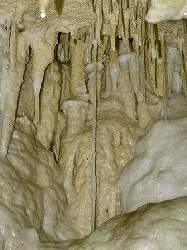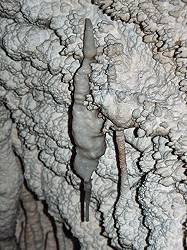Aranui Cave
Useful Information


| Location: |
Near Waitomo.
From Auckland follow State Highway 1 south to Hamilton, then State Highway 3 south to Waitomo. Caves are signposted. 200 km south of Auckland, 70 km from Hamilton, 16 km from Otorohanga. 2 km from Waitomo Caves in Ruakuri Scenic Reserve. (-38.2635577, 175.0800311) |
| Open: |
All year daily at 10, 11, 13, 14, 15. Online booking mandatory. Check in 30 minutes prior at the Glow Worm Cave. Closed 25-DEC. [2024] |
| Fee: |
Adults NZD 75, Children (4-14) NZD 34, Children (0-3) free, Family (2+2) NZD 191. [2024] |
| Classification: |
 Karst Cave Karst Cave
 Glowworm Glowworm
|
| Light: |
 Incandescent Incandescent
|
| Dimension: | |
| Guided tours: | D=60 min. |
| Photography: | allowed |
| Accessibility: | no |
| Bibliography: | |
| Address: | Waitomo Caves, Private Bag 501, Otorohanga, Tel. +64-7-8788227. |
| As far as we know this information was accurate when it was published (see years in brackets), but may have changed since then. Please check rates and details directly with the companies in question if you need more recent info. |
|
History
| NOV-1910 | discovered by Ruruku Aranui. |
| FEB-1912 | official opening by the Minister of Tourism. |
Description
The Aranui Cave is a fairly simply structured cave, consisting more or less of a single horizontal passage with many beautiful speleothems. It has no cave river and only one entrance. Visitors walk up the main passage and then have to turn around and walk back the same path.
At the entrance of Aranui Cave is a large colony of cave wetas, giant spider-like insects. They are not really spiders, although they look similar, but they have only six feet instead of eight. They are closely related to crickets and locusts. Weta is again a Maori language word, which means the ugly one or the spiny one. However, the cave wetas are quite harmless! Cave wetas are adapted to living in dark places and have a good sense of smell, long legs and antennae to feel their way in the dark. Also, they are nearly blind. They leave Aranui Cave only at night foraging on the forest floor for food. During a full moon, they do not leave the cave because there is too much light. Cave wetas are so-called troglobionts, as they live in caves and were altered by the special conditions of the cave.
Aranui Cave is famous for its interesting and beautiful limestone formations. It displays ranges of flowstone, cave coral formations and straw stalactites. Its Cathedral is 20 meters high, stalactites are up to 6 meters long, stalagmites as tall as 3 meters.
The cave is named after a young Maori man, Ruruku Aranui, who discovered it in 1910 as he pursued a wild pig. His dog chased the pig down a steep hill, when the pig and the dog suddenly disappeared. The dog’s barking led Ruruku to a small hole in the side of the hill. He crawled inside, his only lights were some matches, and he found dog and pig in a high chamber that continued into the darkness. At this time the Waitomo caves were already established, so Ruruku Aranui went to Waitomo and told the manager in charge of the caves about his new cave discovery. The cave was much easier to develop than the Glowworm Caves, and after a year it was opened for tours. At first the cave was called Ngutuhihi (the beak of the stitch-bird), but the pronunciation was very difficult, so the Minister of Tourism decided to rename it Aranui Cave after its discoverer.



 Search DuckDuckGo for "Aranui Cave"
Search DuckDuckGo for "Aranui Cave" Google Earth Placemark
Google Earth Placemark Aranui Cave | Waitomo Sightseeing, official website.
Aranui Cave | Waitomo Sightseeing, official website. Index
Index Topics
Topics Hierarchical
Hierarchical Countries
Countries Maps
Maps